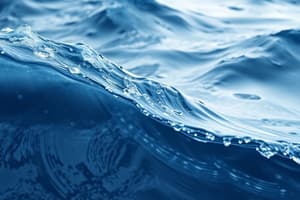Podcast
Questions and Answers
Which statement about the wave is false?
Which statement about the wave is false?
- The frequency of the wave is 0.10 Hz.
- The amplitude is 1.0 m. (correct)
- The wave is traveling in the negative x direction.
- The wavelength of this wave is 2.0 m.
Which equation best represents the wave described with an amplitude of 0.35 m, frequency of 1.05 × 10^6 Hz, and speed of light?
Which equation best represents the wave described with an amplitude of 0.35 m, frequency of 1.05 × 10^6 Hz, and speed of light?
- y = 0.35 sin (6.60 × 10^6t − 0.022x) (correct)
- y = 0.35 sin (6.60 × 10^6t + 0.022x)
- y = 0.35 sin (286t + 1.05 × 10^6x)
- y = 0.35 sin (1.05 × 10^6t + 3.00 × 10^8x)
When a sound wave travels from air into water, how does its wavelength change?
When a sound wave travels from air into water, how does its wavelength change?
- The wavelength initially increases and then decreases.
- The wavelength increases.
- The wavelength remains the same.
- The wavelength decreases. (correct)
What type of sound wave is produced by a loudspeaker?
What type of sound wave is produced by a loudspeaker?
Which frequency range is considered ultrasonic?
Which frequency range is considered ultrasonic?
What quality does the brain interpret from a detected frequency in terms of sound?
What quality does the brain interpret from a detected frequency in terms of sound?
What describes the direction of disturbance in a transverse wave?
What describes the direction of disturbance in a transverse wave?
The change in pressure amplitude relates to which quality of sound?
The change in pressure amplitude relates to which quality of sound?
What is the maximum excursion of a particle from its undisturbed position in a wave referred to as?
What is the maximum excursion of a particle from its undisturbed position in a wave referred to as?
Which type of tone is produced by a sound wave with a single frequency?
Which type of tone is produced by a sound wave with a single frequency?
Which of the following correctly describes frequency in the context of waves?
Which of the following correctly describes frequency in the context of waves?
What is the relationship between the speed, wavelength, and frequency of a wave expressed as?
What is the relationship between the speed, wavelength, and frequency of a wave expressed as?
How can a periodic wave be identified?
How can a periodic wave be identified?
If a wave travels with a velocity of $3 × 10^8 m/s$ and has a frequency of $1230 × 10^3 Hz$, what is its wavelength?
If a wave travels with a velocity of $3 × 10^8 m/s$ and has a frequency of $1230 × 10^3 Hz$, what is its wavelength?
What does the period of a wave represent?
What does the period of a wave represent?
Which type of wave is characterized by disturbances traveling along the same direction as the wave itself?
Which type of wave is characterized by disturbances traveling along the same direction as the wave itself?
What is the relationship between sound intensity and distance from the sound source?
What is the relationship between sound intensity and distance from the sound source?
What is the speed of sound in air at 20 °C?
What is the speed of sound in air at 20 °C?
What is the threshold of hearing in watts per square meter?
What is the threshold of hearing in watts per square meter?
How do large visible ears help animals in detecting low-intensity sounds?
How do large visible ears help animals in detecting low-intensity sounds?
If the sound intensity for listener 2 is 0.10 W/m2 at a distance of 640 m, what will the intensity be for listener 1 at 160 m?
If the sound intensity for listener 2 is 0.10 W/m2 at a distance of 640 m, what will the intensity be for listener 1 at 160 m?
What unit is used for measuring sound intensity?
What unit is used for measuring sound intensity?
Which of the following sound intensities is considered the threshold of pain?
Which of the following sound intensities is considered the threshold of pain?
What happens to the sound pressure variations due to sound waves?
What happens to the sound pressure variations due to sound waves?
Flashcards
Wave
Wave
A traveling disturbance that carries energy.
Transverse Wave
Transverse Wave
A wave where the disturbance is perpendicular to the direction of travel.
Longitudinal Wave
Longitudinal Wave
A wave where the disturbance is parallel to the direction of travel.
Wave Amplitude
Wave Amplitude
Signup and view all the flashcards
Wavelength
Wavelength
Signup and view all the flashcards
Wave Period
Wave Period
Signup and view all the flashcards
Wave Frequency
Wave Frequency
Signup and view all the flashcards
Wave Speed
Wave Speed
Signup and view all the flashcards
Sound's nature
Sound's nature
Signup and view all the flashcards
Sound wave cycle
Sound wave cycle
Signup and view all the flashcards
Pure tone
Pure tone
Signup and view all the flashcards
Frequency and Pitch
Frequency and Pitch
Signup and view all the flashcards
Infrasonic
Infrasonic
Signup and view all the flashcards
Ultrasonic
Ultrasonic
Signup and view all the flashcards
Pressure Amplitude and Loudness
Pressure Amplitude and Loudness
Signup and view all the flashcards
Sound Speed Change
Sound Speed Change
Signup and view all the flashcards
Speed of Sound
Speed of Sound
Signup and view all the flashcards
Sound Intensity
Sound Intensity
Signup and view all the flashcards
Inverse Square Law
Inverse Square Law
Signup and view all the flashcards
Threshold of Hearing
Threshold of Hearing
Signup and view all the flashcards
Threshold of Pain
Threshold of Pain
Signup and view all the flashcards
Large Ears for Better Hearing
Large Ears for Better Hearing
Signup and view all the flashcards
Why does listener 2 hear a quieter sound?
Why does listener 2 hear a quieter sound?
Signup and view all the flashcards
Why does the sound intensity decrease with distance?
Why does the sound intensity decrease with distance?
Signup and view all the flashcards
Study Notes
Waves and Sound
- A wave is a traveling disturbance that carries energy from place to place.
- Waves are classified into transverse and longitudinal waves.
Transverse Wave
- In a transverse wave, the disturbance is perpendicular to the direction of wave travel.
- S waves are an example of transverse waves.
Longitudinal Wave
- In a longitudinal wave, the disturbance is parallel to the line along which the wave travels.
- P waves are an example of longitudinal waves.
Periodic Wave
- A periodic wave consists of repeating cycles or patterns.
- Wavelength (λ) is the distance between successive equivalent points (e.g., crests).
- Period (T) is the time taken for one complete cycle.
Parameters Concerning Waves
- Amplitude is the maximum displacement of a particle from its undisturbed position.
- Wavelength is the distance between two successive equivalent points on the wave.
- Period is the time required for one complete wavelength to pass a given point.
Frequency and Speed
- Frequency (f) is the number of wave cycles per second (Hz).
- Frequency is the reciprocal of period (f = 1/T).
- Speed (v) of a wave is related to its wavelength and frequency (v = fλ).
Example (AM and FM Radio Waves)
- AM and FM radio waves are transverse waves.
- Radio waves travel at 3 × 10⁸ m/s.
- Example calculations are given to determine wavelength from known frequency and speed.
The Mathematical Description of Waves
- The displacement (y) of a particle at position x for a wave moving in the +x direction is given by: y = A sin(2πft - 2πx/λ).
- For a wave moving in the -x direction, the equation is: y = A sin(2πft + 2πx/λ).
Example (Transverse Periodic Wave)
- A problem concerning a transverse periodic wave and its characteristics is provided.
- Students need to determine which statement about the wave is false.
Example (Wave Equation)
- Another problem concerning a wave equation for a wave traveling in the +x direction is given.
- Students need to choose the correct equation that describes the wave.
Check Your Understanding (Sound Wave in Air and Water)
- A loudspeaker produces a sound wave that travels from air into water.
- The frequency of sound remains the same as the source determines the frequency.
- Speed of sound in air is 343 m/s; in water, it is 1482 m/s.
- When the wave enters the water, the wavelength increases.
The Nature of Sound
- Sound is a longitudinal wave; it is created by vibrating objects such as guitar strings or vocal cords.
- Sound waves travel through a medium (solids, liquids, or gases).
- Each sound wave cycle has a compression and rarefaction.
Check Your Understanding (Animal's Hearing)
- Some animals have large ears for greater sensitivity detecting low-intensity sounds.
Check Your Understanding (Sound Intensity on a Surface)
- A sound source emits sound uniformly in all directions.
- Flat surface points facing the source face the same sound intensity.
Problems (Wave Equation)
- Problems concerning wave equations, frequency, wavelength, and speed are provided.
Example (Sound Intensity)
- Intensity problem related to a scenario in which a certain amount of sound power passes through labelled surfaces.
- Sound intensity = power divided by area. SI unit is watts per square meter (W/m²).
Problems (Sound Intensity and Energy)
- Problems relating sound intensity, energy, area, and time.
- Sound intensity at each surface and how loud the sound is perceived by different listeners is examined
Solving for Sound Intensity (Inverse Square Law)
- Problem related to determining sound intensity or power by using the inverse square law.
Sound Intensities and Human Hearing
- The ear responds to a wide range of intensities.
- The threshold of hearing is 10⁻¹² W/m².
- The threshold of pain is 10⁻⁴ W/m².
- High intensities can cause damage to the eardrum.
Studying That Suits You
Use AI to generate personalized quizzes and flashcards to suit your learning preferences.




